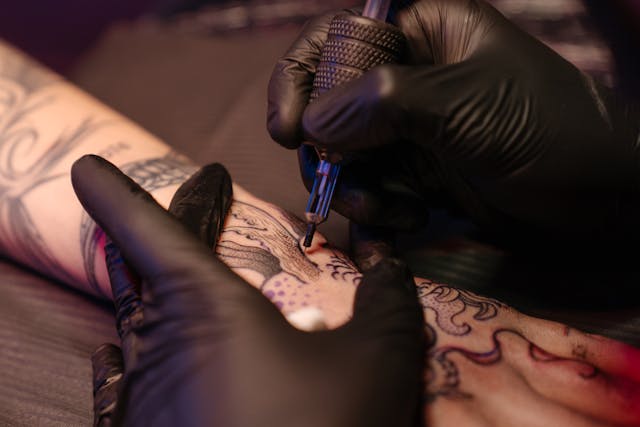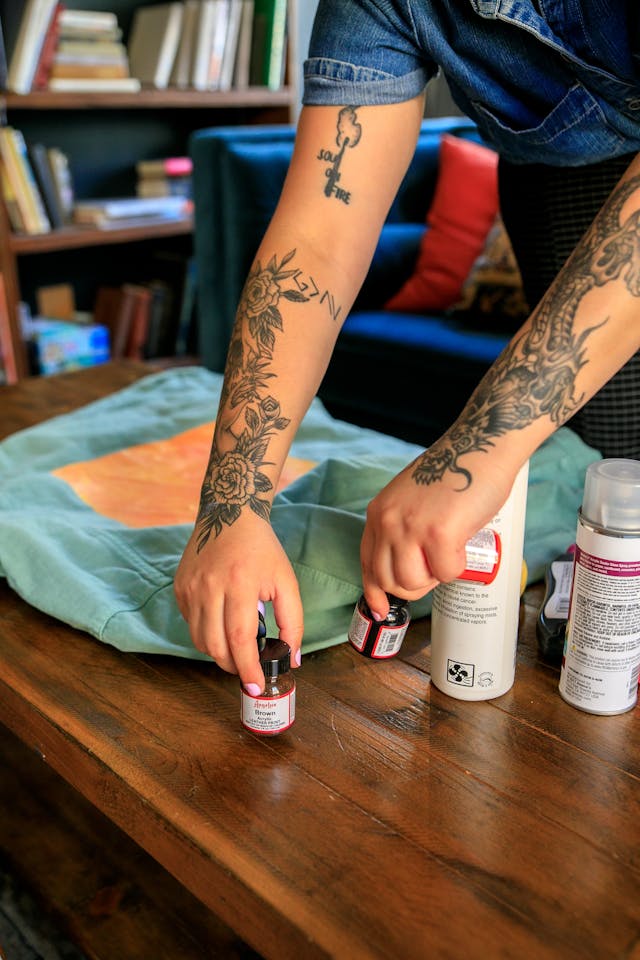Sustainable Practices in the Tattoo Industry
For as long as I can remember, tattoos have fascinated me. They’re more than just body art; they’re visual stories etched into the skin, each design holding a personal significance or cultural meaning. Growing up, I often found myself staring at tattoos on people’s arms, wondering about the stories behind them. But as much as I’ve admired them, I’ve never taken the leap to get one myself. Perhaps it’s my love of minimalism, my indecisiveness about designs, or, truthfully, my fear of needles. Yet, despite my bare skin, I’ve found myself increasingly intrigued by the tattoo industry—not just its artistry but its evolving relationship with sustainability.
Tattoos, as an art form, have an ancient and storied history. They’ve been discovered on the skin of mummies from ancient Egypt and Ötzi the Iceman, a prehistoric man preserved in the Alps. In many cultures, tattoos were sacred, signifying rites of passage, spiritual beliefs, or tribal identity. Today, tattoos have transcended cultural boundaries and become a universal form of self-expression. According to the Pew Research Centre, about 40% of millennials have at least one tattoo, making them a defining feature of contemporary youth culture.
But with popularity comes responsibility. As someone who’s passionate about environmental sustainability, I couldn’t help but wonder: How sustainable is the tattoo industry? What’s the environmental cost of this booming form of self-expression?
These questions took me on a journey into the heart of the tattoo industry, uncovering its practices, challenges, and opportunities for change. From the materials used to the energy consumed, the tattooing process has a surprisingly large environmental footprint. Yet, with awareness and innovation, the industry has the potential to become a beacon of sustainable artistry.

A Growing Industry with a Growing Footprint
The tattoo industry is thriving. In 2022, it was valued at $1.78 billion, with projections suggesting it will reach $4 billion by 2030. As the demand for tattoos grows, so does the industry’s environmental impact.
Let’s break it down:
- Materials: Tattooing relies on a range of disposable items, including gloves, ink caps, barrier films, and needles. These items are typically made from plastic, which doesn’t biodegrade and contributes to pollution.
- Inks: Many traditional tattoo inks contain heavy metals, such as lead, cadmium, and chromium, as well as other toxic chemicals. These substances can leach into the environment during production and disposal.
- Energy Consumption: Tattoo machines, sterilisers, lighting, and heating systems all require electricity. With studios often operating for long hours, their energy usage can be significant.
- Water Usage: Cleaning and sterilising equipment consumes large amounts of water, adding to the industry’s resource demands.
The environmental challenges of tattooing mirror those of other creative industries, but the stakes are uniquely high. Tattoos are permanent, personal, and intimate, meaning clients expect—and deserve—the highest standards of hygiene and quality. Achieving sustainability in this context requires innovation, commitment, and collaboration.
My First Visit to a Tattoo Studio
A few months ago, I decided to visit a tattoo studio—not as a client, but as an observer. I wanted to see the process up close and learn about the materials and tools used. The artist I spoke with, Emma, was kind enough to walk me through the setup. She explained how each client typically generates waste: single-use gloves, ink caps, needles, barrier films, and more.
I was struck by how meticulous everything was. Each item was designed to ensure hygiene and safety, but the environmental trade-offs were undeniable. I asked Emma if she had ever thought about using more sustainable materials. She admitted that while she was aware of the issue, alternatives were expensive or hard to find.
That conversation stayed with me. It was clear that sustainability in tattooing wasn’t just about finding the right supplies—it was about education, accessibility, and commitment.
Learn More: How to Recycle Used Paint Thinner: Expert Guide And Insights
The Role of Consumers
It’s not just tattoo artists and studio owners who shape the industry; consumers play a vital role too. As eco-consciousness grows, many clients are starting to ask questions about the environmental impact of their tattoos. They want to know if the inks are vegan, if the studio recycles its waste, or if the materials used are biodegradable.
This shift in consumer attitudes mirrors trends in other industries, from fashion to food. Just as people now look for organic cotton in their clothing or fair-trade labels on their coffee, they’re beginning to seek sustainability in their tattoos.
During my research, I stumbled upon a TikTok video where someone joked about the future of tattooed grandparents. “Imagine visiting your grandma in 2060, and she’s covered in tattoos,” the video quipped. It was funny, but it also made me think about the long-term implications of our choices. If we’re leaving behind a world of landfills filled with tattooing waste, what kind of legacy is that for future generations?
A Turning Point: The Call for Sustainable Practices
One of the most inspiring moments in my journey came when I listened to a conversation with a tattoo artist named Lucy Frost, who founded the Green House Tattoo Studio in the UK. Lucy is a pioneer in sustainable tattooing, and her story is a testament to what’s possible when passion meets purpose.
“When I started this, there weren’t any alternatives for many of the products we use daily,” Lucy told me. “I had three choices: keep doing what I was doing and ignore the environmental impact, quit tattooing altogether, or find a way to make it work sustainably.”
Lucy chose the third option, sourcing biodegradable gloves, experimenting with plant-based inks, and implementing recycling programs in her studio. She admitted it wasn’t easy—many sustainable products are expensive or hard to find—but the effort was worth it. Today, her studio generates significantly less waste, and her clients are proud to support an eco-conscious business.
Why Sustainability Matters
Sustainability isn’t just a buzzword; it’s a necessity. The tattoo industry, like every other sector, operates within a finite system. Our planet’s resources are limited, and the waste we generate doesn’t just disappear—it accumulates, pollutes, and disrupts ecosystems.
For me, sustainability is personal. Growing up in a household where we valued reuse and resourcefulness, I’ve always felt a sense of responsibility toward the environment. Whether it was turning off lights when leaving a room or repurposing old clothes, small actions were part of my upbringing. So, when I see industries that have room for improvement, I can’t help but feel invested in finding solutions.
The tattoo industry is at a crossroads. With its global popularity and cultural significance, it has the power to set an example for other creative fields. Adopting sustainable practices can ensure that future generations inherit a world where self-expression doesn’t come at the cost of environmental health.
The Environmental Impact of Tattoos
1. Single-Use Materials
Tattooing relies heavily on disposable supplies, from gloves to ink caps and razors. According to a study published in the Journal of Environmental Health, single-use items in medical and beauty practices contribute significantly to landfill waste. Latex, for instance, can take years to decompose, and improper disposal often leads to microplastic pollution.
2. Toxic Inks
Traditional tattoo inks often contain heavy metals like lead, mercury, and cadmium. A recent study by the European Chemicals Agency (ECHA) highlighted that many tattoo inks can leach toxic substances into the environment during disposal. These substances are not only harmful to ecosystems but also raise health concerns for clients and artists alike.
3. Energy Consumption
Tattoo machines, sterilisers, and lighting systems are energy-intensive. According to data from the U.S. Energy Information Administration, the energy consumption of small businesses like tattoo studios is a growing concern, especially as sustainability becomes a global priority.
4. Water Usageaining hygiene in tattoo studios requires significant water use, particularly for cleaning tools and workspaces. In water-scarce regions, this poses additional sustainability challenges.
Sustainable Practices in the Tattoo Industry
The tattoo industry, while steeped in artistry and tradition, is increasingly recognising the need to adopt eco-conscious practices. Here’s a detailed discussion of the most impactful sustainable practices studios and artists can implement to reduce their environmental footprint:
1. Eco-Friendly Ink
Switching to sustainable tattoo inks is one of the most effective ways to minimise environmental harm.
- Vegan Inks: These are made with plant-based pigments and exclude animal by-products, such as glycerine from animal fat or bone char. Vegan inks reduce reliance on animal-based materials and eliminate the ethical concerns surrounding traditional inks.
- Non-Toxic Inks: Free from harmful chemicals like phthalates, formaldehyde, and parabens, these inks are safer for both human health and ecosystems.
- Organic Inks: Derived from natural, sustainable ingredients, these inks minimise the need for synthetic chemicals.
Expert Insight: A study by the European Chemicals Agency (ECHA) highlights the potential health and environmental risks associated with conventional tattoo inks, emphasising the need for safer, non-toxic alternatives.
Learn More: Green Practices in the Digital Nomad Lifestyle: Expert Insights and Sustainable Living

2. Biodegradable and Recyclable Supplies
Tattooing typically involves a significant amount of single-use plastic. Sustainable alternatives include:
- Biodegradable Gloves: These gloves decompose more quickly than traditional latex or nitrile gloves, reducing plastic pollution.
- Compostable Ink Caps: Made from bio-based materials, these caps are an eco-friendly replacement for plastic ones.
- Recyclable Stencil Paper: Using recycled or sustainably sourced paper minimises deforestation.
Implementing a recycling program for materials like metal and plastics further reduces waste. Studios can set up clearly labelled bins to ensure proper segregation and recycling of items like ink caps and used packaging.
3. Digital Transformation
Reducing paper waste is another way studios can lower their environmental impact. Digital tools allow for:
- Electronic Consent Forms: Eliminating the need for printed paperwork.
- Digital Designs: Replacing physical stencils and sketches with digital alternatives reduces paper waste.
Expert Insight: According to a 2023 study published in the European Journal of Sustainable Development Research, transitioning to paperless systems can significantly decrease the carbon footprint of small businesses like tattoo studios.
4. Energy Conservation
Tattoo studios use energy-intensive equipment, including tattoo machines, sterilisers, and lighting. Sustainable energy practices include:
- Energy-Efficient Appliances: Switching to appliances certified for low energy consumption.
- LED Lighting: These consume less energy and last longer than traditional bulbs.
- Renewable Energy: Installing solar panels or purchasing green energy from local providers.
Case Study: Greenhouse Tattoo Studio in the UK has successfully reduced its energy consumption by investing in solar panels and LED lighting, showcasing the feasibility of renewable energy in the industry.
5. Water Conservation
Maintaining hygiene in tattoo studios involves extensive water use. Studios can adopt water-saving measures such as:
- Low-Flow Faucets: Reduce water consumption during cleaning.
- Efficient Sterilisation Systems: Minimise water usage without compromising hygiene standards.
In water-scarce regions, these practices are especially critical for sustainable operations.
6. Sustainable Cleaning Products
Many cleaning products used in tattoo studios contain toxic chemicals that harm the environment. Switching to plant-based, non-toxic alternatives ensures effective cleaning while reducing environmental risks.
- Eco-Friendly Disinfectants: These leave no harmful residues and are biodegradable.
- Natural Cleaning Solutions: Products made from ingredients like vinegar, baking soda, and essential oils offer a safe and sustainable alternative.
7. Waste Management and Recycling Programs
Effective waste management is crucial for sustainability in tattoo parlours. This includes:
- Proper Disposal of Sharps: Used needles and other medical waste must be placed in puncture-proof containers and disposed of via certified medical waste removal services.
- Recycling Non-Hazardous Items: Recycling ink bottles, packaging, and other materials reduces landfill waste.
- Composting Biodegradable Waste: Items like plant-based gloves and stencil papers can be composted instead of thrown away.
8. Sustainable Packaging
Tattoo aftercare products often come in plastic packaging. Switching to sustainable packaging options helps reduce plastic waste:
- Refillable Containers: Allow clients to reuse packaging for aftercare balms and lotions.
- Biodegradable Packaging: Reduces long-term pollution.
Learn More: What Is Eco-Friendly? Key Practices, Global Examples, and Future Innovations
9. Promoting Client Education
Clients play a role in sustainability, too. Tattoo artists and studios can educate clients on eco-friendly practices, such as:
- Using Natural Aftercare Products: Shea butter, coconut oil, and essential oils are excellent natural alternatives.
- Recycling Aftercare Packaging: Encouraging clients to recycle empty containers.
10. Ethical Business Practices
Sustainability extends beyond materials and waste management. Ethical business practices include:
- Sourcing Local Materials: Reduces transportation emissions and supports local economies.
- Supporting Green Suppliers: Partnering with suppliers committed to sustainable practices.
Expert Insight: Lucy Frost, founder of Greenhouse Tattoo Studio, emphasises the importance of sourcing eco-friendly materials: “When I started, I struggled to find alternatives. But working with green suppliers allowed me to align my business with my values.”
Innovations in the Tattoo Industry
The tattoo industry is evolving, with new technologies and materials driving sustainability.
1. 3D Printing
Some artists are using 3D printing to create reusable stencil templates, reducing paper waste. This technology also allows for highly detailed designs, enhancing the client experience.
2. Plant-Based Alternatives
Researchers are developing plant-based plastics for items like ink caps and gloves. These materials are biodegradable, making them a game-changer for waste reduction.
3. Digital Innovations
Going paperless is another way studios are cutting down on waste. Digital consent forms, appointment scheduling, and design previews eliminate the need for paper entirely.
Empowering Clients
As consumers, we have the power to drive change. Here are ways to support sustainable tattooing:
- Ask Questions: Inquire about the studio’s sustainability practices before booking an appointment.
- Choose Eco-Friendly Studios: Support businesses that prioritise environmental responsibility.
- Opt for Vegan Inks: If sustainability matters to you, request vegan or organic inks.
- Follow Eco-Friendly Aftercare: Use natural, biodegradable products for tattoo aftercare, such as shea butter or coconut oil.
Conclusion
The tattoo industry is at a turning point. With growing awareness and innovation, it has the potential to become a leader in sustainable artistry. From adopting biodegradable supplies to conserving energy and water, the steps are clear—and the impact is significant.
As someone who admires tattoos but remains ink-free, I find it inspiring to see artists and clients coming together to make a difference. Whether you’re a seasoned tattoo enthusiast or someone considering their first design, I hope this article empowers you to prioritise sustainability in your choices.
Because at the end of the day, tattoos aren’t just about self-expression—they’re about leaving a mark on the world. Let’s ensure that the mark is a positive one.







